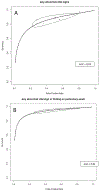Signs and Symptoms That Rule out Community-Acquired Pneumonia in Outpatient Adults: A Systematic Review and Meta-Analysis
- PMID: 30850460
- PMCID: PMC7422644
- DOI: 10.3122/jabfm.2019.02.180219
Signs and Symptoms That Rule out Community-Acquired Pneumonia in Outpatient Adults: A Systematic Review and Meta-Analysis
Abstract
Background: A systematic review of clinical decision rules to identify patients at low risk for community-acquired pneumonia (CAP) has not been previously presented in the literature.
Methods: A systematic review of MEDLINE for prospective studies that used at least 2 signs, symptoms, or point-of-care tests to determine the likelihood of CAP. We included studies that enrolled adults and adolescents in the outpatient setting where all or a random sample of patients received a chest radiograph as the reference standard. We excluded retrospective studies and studies that recruited primarily patients with hospital-acquired CAP.
Results: Our search identified 974 articles, 12 of which were included in the final analysis. The simple heuristic of normal vital signs (temperature, respiratory rate, and heart rate) to identify patients at low risk for CAP was reported by 4 studies and had a summary estimate of the negative likelihood ratio (LR-) of 0.24 (95% CI, 0.17 to 0.34) and a sensitivity of 0.89 (95% CI, 0.79 to 0.94). The simple heuristic of normal vital signs combined with a normal pulmonary examination to identify patients at low risk for CAP was reported by 3 studies, and had a summary estimate of LR- of 0.10 (95% CI, 0.07 to 0.13) with an area under the receiver operating characteristic curve of 0.92.
Conclusions: Adults with an acute respiratory infection who have normal vital signs and a normal pulmonary examination are very unlikely to have CAP. Given a baseline CAP risk of 4%, these patients have only a 0.4% likelihood of CAP.
Keywords: Community-Acquired Infections; Meta-Analysis; Outpatients; Pneumonia; Prospective Studies; Systematic Review.
© Copyright 2019 by the American Board of Family Medicine.
Conflict of interest statement
Conflict of interest: none declared.
Figures
Comment in
-
Re: Signs and Symptoms That Rule Out Community-Acquired Pneumonia in Outpatient Adults: A Systematic Review and Meta-Analysis.J Am Board Fam Med. 2019 Sep-Oct;32(5):753. doi: 10.3122/jabfm.2019.05.190132. J Am Board Fam Med. 2019. PMID: 31506374 No abstract available.
-
Confidently rule out CAP in the outpatient setting.J Fam Pract. 2021 Apr;70(3):140-142. doi: 10.12788/jfp.0174. J Fam Pract. 2021. PMID: 34314338
References
-
- Pfuntner A, Wier LM, Stocks C. Most Frequent Conditions in U.S. Hospitals, 2011: Statistical Brief #162 In: Healthcare Cost and Utilization Project (HCUP) Statistical Briefs. Rockville, MD: Agency for Healthcare Research and Quality (US); 2006. - PubMed
-
- CDC. Deaths: Final Data for 2015. National Vital Statistics Report. Available from: https://www.cdc.gov/nchs/data/nvsr/nvsr66/nvsr66_06_tables.pdf. Accessed February 16, 2018. - PubMed
-
- Centor RM, Witherspoon JM, Dalton HP, Brody CE, Link K. The diagnosis of strep throat in adults in the emergency room. Med Decis Making 1981;1: 239–246. - PubMed
Publication types
MeSH terms
Grants and funding
LinkOut - more resources
Full Text Sources
Medical
Miscellaneous


